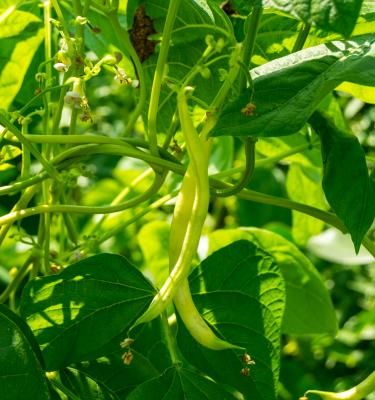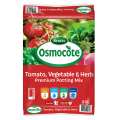

How to grow Runner Beans
Runner beans, or more correctly scarlet runner beans, (Phaseolus coccineus) are among the easiest and most rewarding vegetables to grow. And with their colourful flowers and heart-shaped leaves, they look as good as they taste. Follow our simple guide for a bountiful harvest of runner beans.
Best runner beans to plant
Whether you're planting runner beans in rows in your own vegie plot or just growing a few plants in a pot, there are plenty of varieties to choose from. Here are some of the most popular:
Painted Lady (red and white flowers), Scarlet Runner (brilliant red flowers), Sunset Runner (salmon pink flowers), Scarlet Emperor (bright orange-red flowers).
Essential equipment
To grow runner beans you will need:
- Bean seeds
- Small pots
- Seed raising or vegetable and herb potting mix
- 2.5m long poles to create a support framework
- String
- Garden fork and spade
- Compost or soil improver
When and where to plant runner beans
Sow runner beans indoors in seed trays in mid-spring, or sow directly into the ground outdoors in late spring and early summer once all risk of frost is gone.
A rich, well-drained soil in full sun is ideal for planting runner beans. You can also grow them in containers tilled with premium quality potting mix.
Sowing runner beans indoors
- Fill small pots with potting mix or seed raising mix.
- With a dibber or pencil, make a hole 5cm deep in the mix and drop in a bean seed. Plant one seed per pot and sow a few extra pots in case seeds fail to germinate.
- Cover over with mix and firm it down gently.
- Water the pots and put them on a sunny windowsill or warm spot outdoors to germinate. This should take about one week.
- Let the seedlings grow on until all risk of frost is past, then plant them out.
Sowing runner beans directly into the vegetable garden
- Dig the area over a few weeks before planting, breaking the soil up and clearing it of weeds. Dig in some well weathered manure or compost to improve the soil structure and drainage.
- Rake the soil to create a level surface with a light, crumbly texture.
- Put in sturdy supports for the bean plants, such as two rows of poles sloping towards each other. Traditionally. the poles are tied together at the tops to create an A-frame but tying them in the middle to create an X-shape makes it easier to pick the beans, as they are not all clustered together at the top of the frame. Space the poles 45-60cm apart. If you are only growing a few plants, a wigwam or tripod of poles makes a good support for them to climb up.
- Sow the bean seed 5cm deep, sowing two seeds at the base of each pole.
- Water regularly.
- Once the seedlings are around 10cm tall, pull out the weaker seedling and retain only the strongest of each pair.
Tips on caring for runner beans
- Beans will twine automatically around their supports, but you may need to tie the young seedlings to the poles at first.
- Once the plants reach the tops of the supports, pinch out the growing tips. This will encourage the plants to put out side shoots and bush up, resulting in more beans.
- Water regularly, especially during dry periods and when the flowers are setting (developing into beans).
- Protect young plants from slugs and snails, using crushed eggshells, sawdust, beer traps, copper tape or snail and slug pellets.
- Colonies of aphids often appear on young shoots. In large masses they can distort the plant's growth and reduce vigour. Check young plants and wipe off aphids as soon as you see them to stop them becoming a problem. Natural predators like ladybirds will help to control infestations. If using pesticide sprays, always check that they are suitable for use on edible plants. To avoid harming pollinators, don't spray when the plants are in flower.
- In hot, dry weather, flowers sometimes drop off the plant without developing into beans. Regular watering will help and the problem usually resolves itself once cooler weather returns.
Growing runner beans in containers
If you're short on space, dwarf runner beans are ideal for containers, growing into bushy plants around 45cm tall.
- Choose a container at least 30cm in diameter, with good drainage holes. Fill with premium quality vegetable potting mix.
- Sow seeds 5cm deep directly into the mix in late spring or start seedlings in trays in mid-spring and transplant into the container once they are big enough (around 10cm tall).
- Water regularly and feed the plants with a vegetable fertiliser) fortnightly once the flowers start setting.
Harvesting runner beans
Harvest runner beans when the pods are between 15-20cm long, before the beans start to swell in the pods. Harvesting runner beans encourages the plant to produce more, so pick frequently.
Common problems and pests of runner beans
| Pods failing to set |
One of the most common runner beans problems is plants flowering but failing to develop pods. This can be caused by a range of environmental conditions including very hot weather, lack of water, few pollinators and birds damaging flowers. The problem often resolves itself as the season progresses.
|
|---|---|
| Whitefly |
Whitefly is a small black sap-sucking insect that infests the soft new shoots on bean plants, stunting and distorting them. The best way to get rid of this pest on runner beans is to check regularly and tackle the problem as soon as it appears.
|
| Slugs and snails |
Slugs and snails will eat the leaves of young runner bean seedlings and can be identified by the slime trails that they leave, as well as the damage they do. As the plants grow taller, they are less at risk of slug and snail damage.
|



